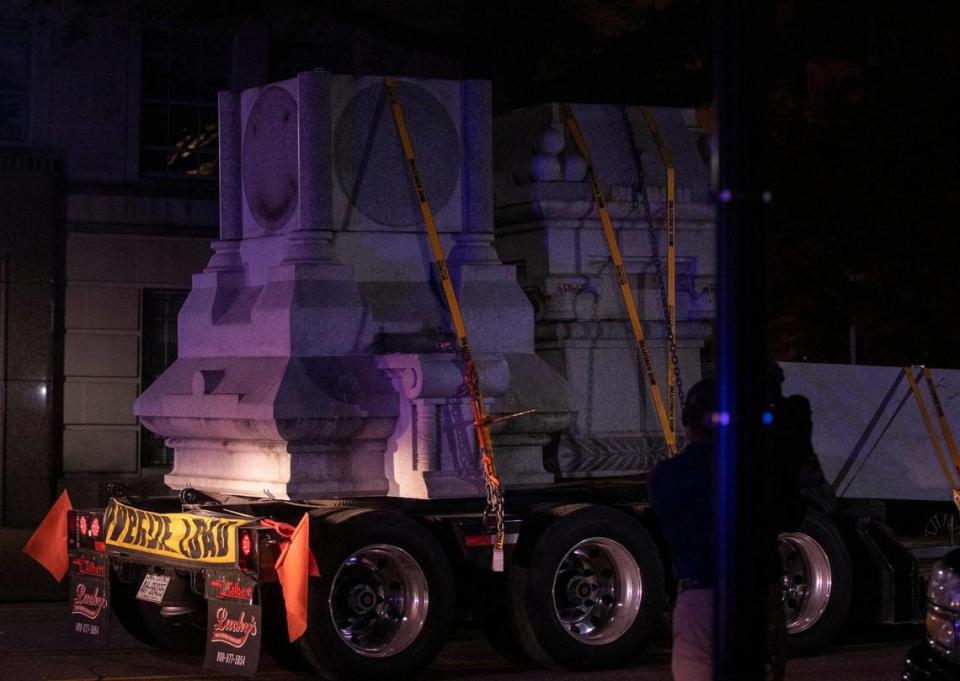Witnessing ‘a new history.’ Confederate statue comes down in NC after 125 years.
At the time of its unveiling in 1895, the Confederate Monument at the state Capitol seemed destined to stand forever, same as the laws and customs throughout the South that often determined a man’s worth by the color of his skin. The people who erected that monument 125 years ago, who celebrated it like a victory, could never envision a day when it might come down.
But that day arrived in the final hours of Tuesday night, in front of a small crowd that came to bear witness.
“The people that are out here, the people who have been out here, even though we haven’t seen much movement since Sunday — it’s kind of like you want to witness an old part of history,” said Kenny Lee, a Black man who grew up in North Carolina, while the monument came down. “And at the same time you’re witnessing a new history.”
The monument was removed four days after protesters ripped away two statues that stood near its base. Protesters on Friday night dragged those statues, depicting Confederate soldiers, through the streets of downtown Raleigh. They hung one from a stoplight pole and left the other outside the courthouse.
The unrest followed weeks of protests locally and nationally in the aftermath of the death of George Floyd, a Black man who was killed after a police officer in Minneapolis knelt on his neck for nearly nine minutes, and prompted North Carolina Gov. Roy Cooper to remove three Confederate monuments from the grounds of the Capitol. Citing the need to protect public safety, Cooper’s order on Saturday called for removing the remainder of the monument and two smaller memorials nearby — the monument to the Women of the Confederacy and the Henry Wyatt Monument.
For three days, workers attempted to disassemble the 75-foot tall monument, which was described as “one of the handsomest granite monuments in America” when it rose. On Sunday morning, while two women provided a melodic soundtrack of spirituals and hopeful Gospel music, those workers lifted away the statue of the Confederate soldier that stood atop the monument, facing west down Hillsborough Street.
The granite pillar beneath that infantryman, though, proved resistant to change, like the time in which it was built.
Workers using one crane failed to separate the pillar on Sunday. Another group, with a larger crane, failed as Monday night turned into Tuesday morning. It was as if that pillar, which for so long had held that Confederate soldier high in the air, supporting him while he looked out onto the city, had been built to stand forever.
Tuesday night finally brought a moment more powerful than the granite. After hours of preparation, workers secured towing straps to the pillar, beneath metal rods they’d drilled into its sides. A few minutes before 11:30 p.m., the crane attempted to separate the pillar from the rest of the monument.
There was quiet and then a loud snapping sound, and for a moment, the pillar lurched to one side before righting itself. The crew members appeared to consider their next move. Then, suddenly, the pillar hung in the air.
At 11:30, the crane lifted it from what remained beneath. In an instant, the pedestal that for 125 years held high the statue of the Confederate soldier that kept watch over North Carolina’s Capitol stood no more.
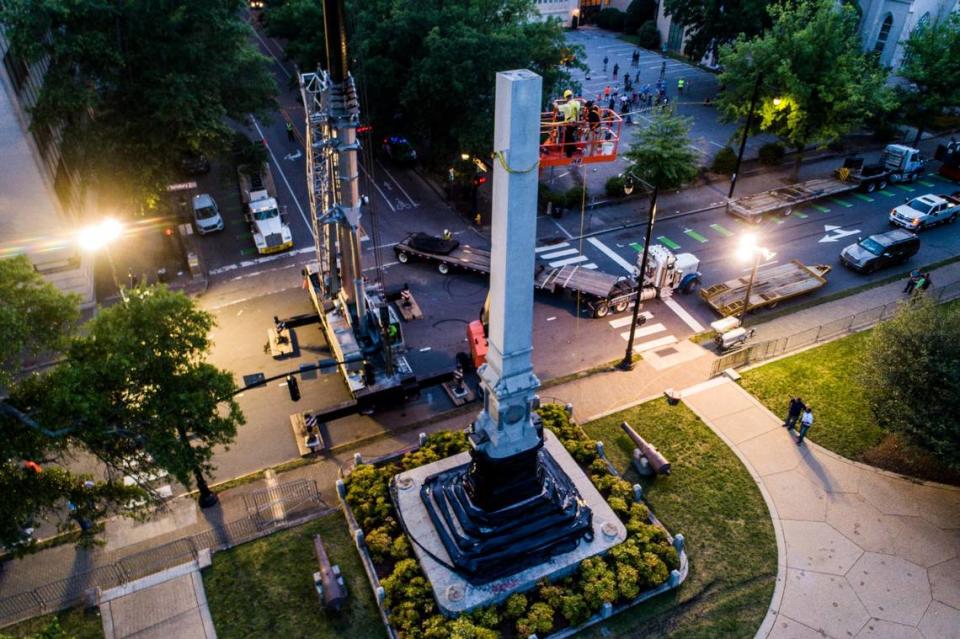
People cheered when it happened. A small crowd of perhaps a few dozen had gathered in the parking lot of the First Baptist Church, across Salisbury Street from the monument. Some had been waiting for hours, sitting in camping chairs and watching. One group of friends brought two pizzas and sat under the police tape that created a perimeter, which kept onlookers at a distance.
Lee, who spoke of a desire to see “new history,” was among them. He did not want to reveal his age, but said he was older than 50. He wore a baseball hat, carried a camera and sat on the ground, staring ahead toward the monument while crews worked.
He’d long become familiar with the old arguments surrounding structures like this, the people who said they represented heritage and not hatred. When he looked at the monument, Lee saw a glorification of an Army that fought to keep his ancestors enslaved.
“Some would say that you’re erasing history and getting rid of history and so forth,” he said. “But we’re just creating a new future, you know what I’m saying? And so this is just a small step. It’s just a small step right here.
“We’ve got to get rid of some of these images of supremacy — white supremacy.”
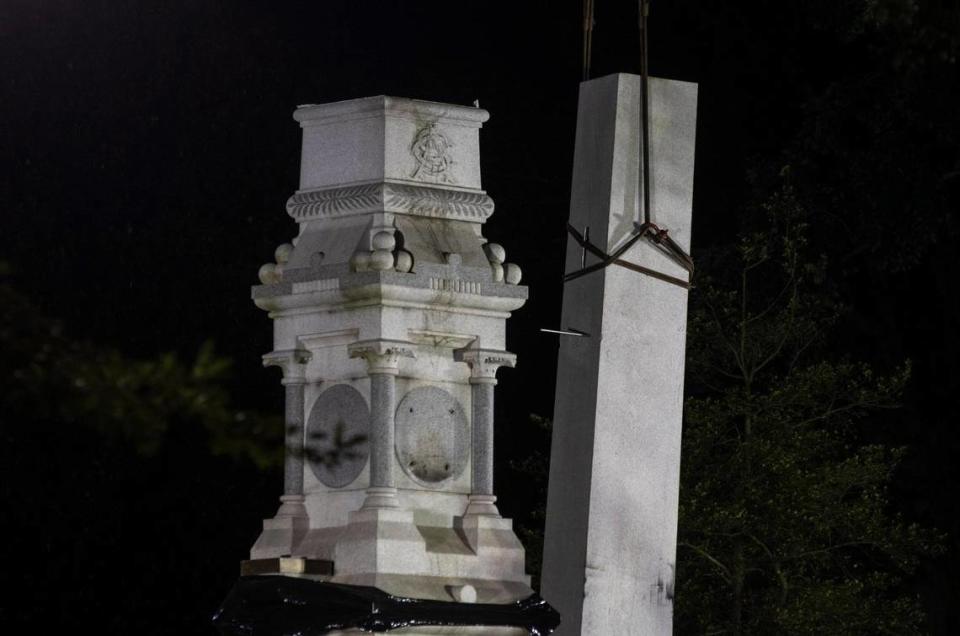
North Carolina statue’s history
For 125 years, the monument had cast a long shadow, one that stretched across Hillsborough Street every morning around sunrise. In this moment of national uprising, the monument’s figurative shadow, and what it represented to generations of Black people in North Carolina, intersected with the breaking point that arose after Floyd’s death.
To understand the story of how the monument came down was to understand how it went up in the spring of 1895, 30 years after the end of the Civil War. The monument rose, like so many others like it throughout the South, amid considerable celebration of the “lost cause” during the post-Reconstruction era.
First, the May 21, 1895 edition of The NandO described the monument dedication, which happened the day before, as "a perfect day." Estimated crowd at 30K. "The shaft will forever stand as a monument" to the Confederacy. pic.twitter.com/xXv9PtGa6K
— Andrew Carter (@_andrewcarter) June 24, 2020
In Raleigh, The News & Observer estimated 30,000 attended the monument’s unveiling on May 20, 1895. Among them were thousands of Confederate veterans who received a hero’s welcome. The day after the dedication, The N&O described it as a “perfect day.” That came after the paper wrote that the dedication would be “the greatest day in the history of Raleigh.”
Among the keynote speakers that day was Alfred Moore Waddell, a Confederate veteran who, according to The N&O, gave “a masterly defence (sic) of the cause for which” the South fought during the Civil War. During his speech, Waddell downplayed the role of slavery in the South’s secession, and provided a fawning account of North Carolina’s role in the war.
Three years after his speech, Waddell in 1898 became the mayor of Wilmington after he led a violent coup to overthrow the city’s government. Before the coup, Wilmington’s local government included a strong contingent of Black elected officials. After, the city’s Black residents began fleeing.
In some ways, and to some people, the Confederate Monument that stood for so long at the Capitol in Raleigh represented not the valor of young soldiers who died fighting for something they believed in. Instead, to a number that’s grown over the years, the monument came to represent something closer to what Waddell helped carry out in Wilmington.
Its removal comes in spite of a law North Carolina passed in 2015 restricting the removal of Confederate monuments from government property. Three years later, the state’s historical commission voted to keep three Confederate memorials on the grounds of the Capitol — the same three that have been removed since Saturday.
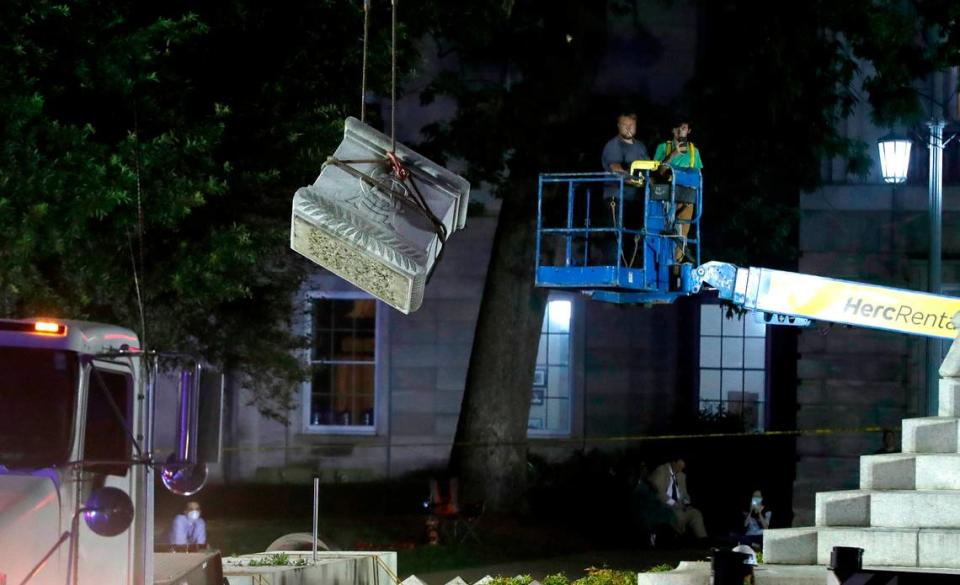
Statue removal ‘a long time coming’
When the first workers arrived to remove the monument Sunday morning, a small crowd gathered. Among them were Carly Prentis Jones and Shana Tucker, two friends and musicians who provided a soundtrack to the scene. Over the years, Jones and Tucker, both of whom are Black, felt discomfort every time they encountered the monument, or ones like it.
“I grew up in Raleigh, looking at these every time I came downtown,” Jones told The N&O Sunday.
A little ways away, Sheila Jones stood in the shade of a tree and watched workers place the monument’s last remaining Confederate soldier statue on a flatbed truck. She is 50 and works for the city, and she said she’d taken an early break from work to see the monument’s deconstruction. She could remember visiting the Capitol as a child, and the sanitized version of history she learned in school.
“When I was little, this was the only thing they taught in school,” she said of the mythology surrounding the Confederacy. “This is the only thing you knew.”
Watching that statue come to rest on Sunday, lying on its back as if accepting defeat, Sheila Jones stared ahead quietly, capturing the moment on her phone. It was, she said, “a long time coming.”
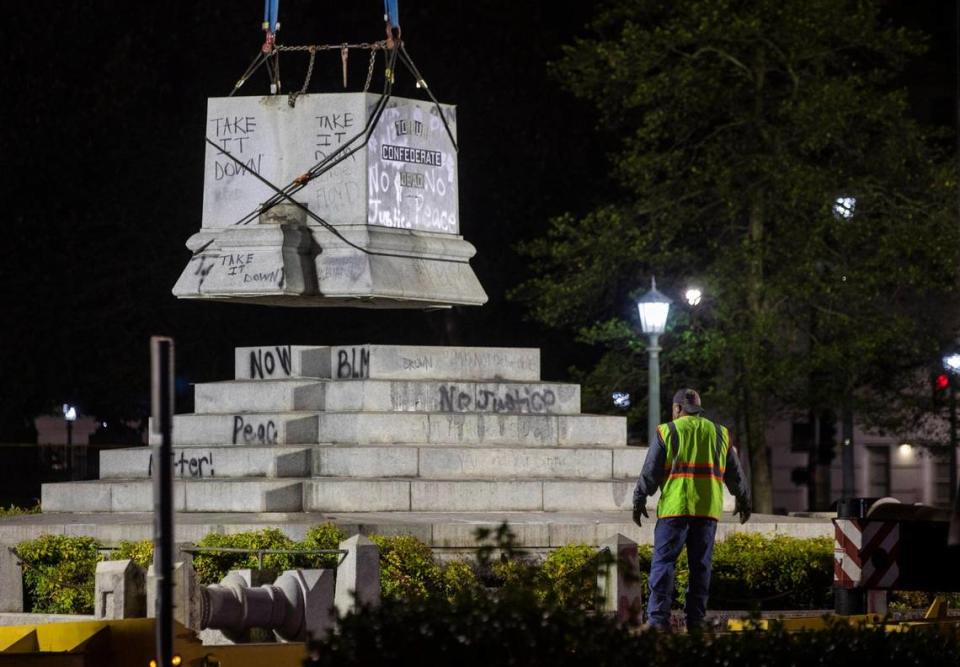
Attempts to remove statue
It took more than two days, and attempts with three cranes, to bring down the rest of the monument.
It did not fall easily, and that was because it’d been built with the thought that it would never fall at all. Indeed, the day after its dedication, a story on the front page of The N&O began with the confident proclamation that the monument would “forever stand.”
Instead, it remained on the grounds of the Capitol for almost 46,000 days. It remained there through two turns of the century; through decades of Jim Crow laws in North Carolina; through the Civil Rights movement and through the tenure of America’s first Black president. It remained there until, finally, a movement grew too powerful — or what the monument represented too weak.
By early Wednesday morning, the only thing that remained of the monument was its stairs. The rest had been hauled away.
Cooper’s press secretary, Dory MacMillan, has said the monuments are being stored “in a secure facility until it can be determined where they should be kept permanently.”
The majority of those who arrived near the Capitol on Tuesday night, meanwhile, expressed joy while the monument slowly disappeared from the grounds.
“I felt light-headed,” Esco Latimer said, after he stayed to watch the monument’s removal until past 1:30 Tuesday morning. Latimer, 45, is a board member of the local African-American Caucus. Seeing the monument come down, he said, “was like a revelation just came over me.”
“It’s almost like a fog has been lifted. It’s been cleared through the state (Capitol) building. And the African-American Caucus Board, for it to be up the street, we will now be able to see straight to the state Capitol. Before, (the monument) was blocking our vision.”
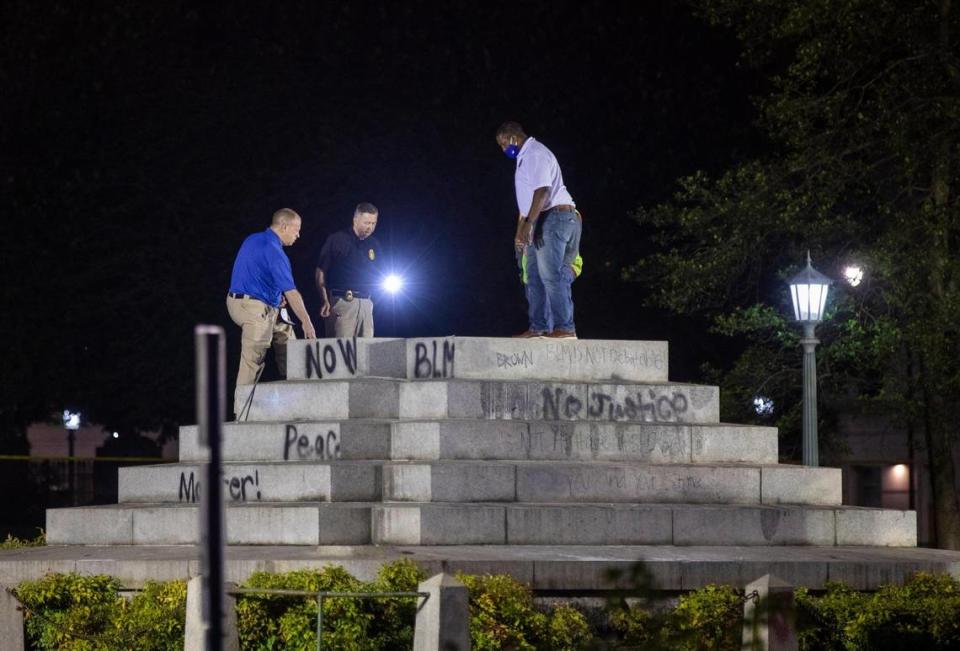
Watching the monument grow shorter, Latimer said, felt “almost like my ancestors were set free ... and they were flying up.”
For 125 years, anyone traveling east on Hillsborough Street would have reached a dead-end at the Confederate Monument. For 125 years, it was ever-present.
It awaited people filing out of the church across the street. It awaited school children on field trips to the Capitol. The world changed around it, but the monument always stayed the same.
It stood as tall, or nearly as tall, as any of the oak trees nearby, and in time it came to divide people almost as much as the war that led to its creation. It stood for the final time on Tuesday, already a shell of itself, abandoned.
When Wednesday began, daylight shined through a space it hadn’t in a long time.
Staff writer Ashad Hajela contributed to this story.
